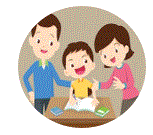It’s never too early to explore numbers, counting or shape with your child. Real life often provides the best opportunities to develop maths skills and talking about numbers around you early and often will highlight to your child that numbers, counting and shape are part of everyday life. There are lots of fun and easy things you can try to help your child to explore numbers and shapes, giving them a great start to developing early maths skills, concepts and confidence.
Sing – even if it isn't your strong point! Sing counting songs, such as '10 Green Bottles', '1, 2, Buckle My Shoe’ and ‘1, 2, 3, 4, 5, Once I Caught a Fish Alive’. Singing songs is a good way for children become familiar with counting. Don't worry if they choose the same songs again and again!
Click the link below to have a whole playlist of counting songs.
Numbers are all around us, from calendars to door numbers, street signs to car registration plates. Pointing them out and talking about them with your child can show that they have a real life context.
about them with your child can show that they have a real life context.
Find numbers in magazines, on the telephone or the remote control. Press the telephone numbers together when you're using the phone. Point to each number in the telephone number and read the number aloud. Use the TV remote control together, point to the numbers and then read the number aloud as you change the channel.
 Try pointing out numbers when you’re out and about – on front doors, the front of buses and train platforms. Choose a 'Number of the Week' and see how many times you can spot this number, around the house, out in the street or in the supermarket.
Try pointing out numbers when you’re out and about – on front doors, the front of buses and train platforms. Choose a 'Number of the Week' and see how many times you can spot this number, around the house, out in the street or in the supermarket.
Learning to recognise the shapes of numbers is as important as knowing how to count out loud, and introducing these symbols early will help your child to get familiar with them.
Count whenever you can – remember practise makes perfect! Count how many stairs there are, or how many toy crayons or toy cars they have. Don’t worry if children remember the answer – they can count to check!
Ask young children to help you sort the cutlery or th e laundry – counting as you sort.
e laundry – counting as you sort.
Try following a recipe together, talking about the numbers in the recipe and counting ingredients: ‘We need 2 scoops of flour. We need 1 cherry for each cake.'
Help your child to learn the numerals by exploring their shapes. Have fun forming numbers in sand with a stick, on the pavement with chalk or on sheets of paper with finger paints. Make numbers out of modelling clay. Try holding their finger and forming the number in the air.
in sand with a stick, on the pavement with chalk or on sheets of paper with finger paints. Make numbers out of modelling clay. Try holding their finger and forming the number in the air.
 Point out different shapes around you whenever possible. Choose a 'Shape of the Week' and then see how many times you can spot this shape around you. Ask your child to describe the shape to you. Think about the number of sides and corners a shape has: 'Look at this rectangle. How many sides are the same length? 'Look at this cube. Count how many corners it has.'
Point out different shapes around you whenever possible. Choose a 'Shape of the Week' and then see how many times you can spot this shape around you. Ask your child to describe the shape to you. Think about the number of sides and corners a shape has: 'Look at this rectangle. How many sides are the same length? 'Look at this cube. Count how many corners it has.'
- Dinosaur Dig!by Penny Dale – This inventive counting story manages to combine diggers, dinosaurs and counting.
 Ten Little Fingersand Ten Little Toes by Mem Fox and Helen Oxenbury – Illustrated beautifully by the illustrator of We’re Going on a Bear Hunt, this story is ideal for young children.
Ten Little Fingersand Ten Little Toes by Mem Fox and Helen Oxenbury – Illustrated beautifully by the illustrator of We’re Going on a Bear Hunt, this story is ideal for young children.- One Ted Falls Out of Bedby Julia Donaldson and Anna Currey – This magical story by the author of The Gruffalo has a counting theme and rhyming text. It’s all about the fun that toys have while children are fast asleep.
- One Mole Digging A Holeby Julia Donaldson and Nick Sharratt – Another counting, rhyming story by children’s favourite, Julia Donaldson. From moles digging holes to parrots pulling up carrots, the wacky and wonderful illustrations by Nick Sharratt are sure to make counting fun!
Top tips for parents and families
Be positive about maths. Don't say things like "I can’t do maths" or "I hated maths at school"; your child might start to think like that themselves.
Point out the maths in everyday life. Include your child in activities involving maths such as using money, cooking and travelling.
Praise your child for effort rather than talent - this shows them that by working hard they can always improve.




